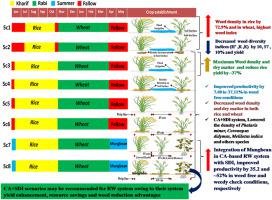当前位置:
X-MOL 学术
›
Crop Prot.
›
论文详情
Our official English website, www.x-mol.net, welcomes your feedback! (Note: you will need to create a separate account there.)
Conservation agriculture layered with subsurface drip fertigation influences weed dynamics, weed indices and productivity of rice-wheat system
Crop Protection ( IF 2.5 ) Pub Date : 2024-05-25 , DOI: 10.1016/j.cropro.2024.106761 Manish Kakraliya , H.S. Jat , R.S. Chhokar , Suresh Kumar , Madhu Choudhary , P.C. Sharma , M.L. Jat
Crop Protection ( IF 2.5 ) Pub Date : 2024-05-25 , DOI: 10.1016/j.cropro.2024.106761 Manish Kakraliya , H.S. Jat , R.S. Chhokar , Suresh Kumar , Madhu Choudhary , P.C. Sharma , M.L. Jat

|
A three-year field study was conducted to explore the use of Conservation Agriculture (CA) as a cost-effective alternative to conventional tillage (CT) in rice-wheat (RW) systems. Therefore, to minimize the weed menace while sustaining the system productivity, a three-year field study was undertaken with different CA-based practices layered with flooded (FI) and subsurface drip irrigation (SDI). In rice, weed density (WD) in Sc8 {Zero tillage direct seeded rice with residue (+R) and SDI} recorded 72.9% lowered then Sc1 (CT-Puddled transplanted rice) after three years. However, maximum WD (162 m) and dry matter (WDM; 772.8 g m) were recorded in ZTDSR without residue (-R) with FI (Sc3) during third year which reduced rice yield by ∼37%. In wheat, the WD and WDM of and other species lowered in CA with SDI system (Sc5-Sc8) than CTRW system (Sc1 and Sc2). Lowest weed index (WI) observed with Sc8 during third year, while diversity indices (H’, R, E) increased by 10, 57 and 10% under SDI system than CTW-R scenario (Sc1). CA-system improved productivity by 7.40–37.11% over CTRW systems in weed free (WF) conditions, regardless of residue and irrigation management. Under weedy check (WC), Sc8 was top yielder with yield of 8.32 Mg ha. Moreover, sustainable intensification (Sc7-Sc8) improved productivity by 35.2 and ∼52% than CTRW systems in WF and WC plots, respectively. In conclusion, CA+SDI scenarios may be recommended for RW system owing to their system yield enhancement, resource savings and weed reduction advantages.
中文翻译:

保护性农业分层地下滴灌施肥对稻麦系统杂草动态、杂草指数和生产力的影响
进行了为期三年的实地研究,以探索在稻麦(RW)系统中使用保护性农业(CA)作为传统耕作(CT)的经济高效替代方案。因此,为了在维持系统生产力的同时最大限度地减少杂草威胁,我们对不同的基于 CA 的实践进行了为期三年的实地研究,并采用漫灌 (FI) 和地下滴灌 (SDI) 分层。在水稻中,三年后,Sc8{带有残留物(+R)和SDI的零耕直播水稻}中的杂草密度(WD)比Sc1(CT搅拌插秧水稻)降低了72.9%。然而,第三年,使用 FI (Sc3) 在 ZTDSR 中记录了最大 WD (162 m) 和干物质 (WDM;772.8 g m),无残留 (-R),这使水稻产量降低了约 37%。在小麦中,SDI系统(Sc5-Sc8)的CA中的WD和WDM比CTRW系统(Sc1和Sc2)降低。第三年,Sc8 观察到杂草指数 (WI) 最低,而 SDI 系统下的多样性指数 (H’、R、E) 比 CTW-R 方案 (Sc1) 增加了 10%、57% 和 10%。在无杂草 (WF) 条件下,无论残留物和灌溉管理如何,CA 系统比 CTRW 系统提高了 7.40–37.11% 的生产力。在杂草检查 (WC) 下,Sc8 的产量最高,产量为 8.32 毫克公顷。此外,在 WF 和 WC 地块中,可持续集约化 (Sc7-Sc8) 的生产率分别比 CTRW 系统提高了 35.2% 和 ∼52%。总之,由于具有提高系统产量、节省资源和减少杂草的优势,CA+SDI方案可能被推荐用于RW系统。
更新日期:2024-05-25
中文翻译:

保护性农业分层地下滴灌施肥对稻麦系统杂草动态、杂草指数和生产力的影响
进行了为期三年的实地研究,以探索在稻麦(RW)系统中使用保护性农业(CA)作为传统耕作(CT)的经济高效替代方案。因此,为了在维持系统生产力的同时最大限度地减少杂草威胁,我们对不同的基于 CA 的实践进行了为期三年的实地研究,并采用漫灌 (FI) 和地下滴灌 (SDI) 分层。在水稻中,三年后,Sc8{带有残留物(+R)和SDI的零耕直播水稻}中的杂草密度(WD)比Sc1(CT搅拌插秧水稻)降低了72.9%。然而,第三年,使用 FI (Sc3) 在 ZTDSR 中记录了最大 WD (162 m) 和干物质 (WDM;772.8 g m),无残留 (-R),这使水稻产量降低了约 37%。在小麦中,SDI系统(Sc5-Sc8)的CA中的WD和WDM比CTRW系统(Sc1和Sc2)降低。第三年,Sc8 观察到杂草指数 (WI) 最低,而 SDI 系统下的多样性指数 (H’、R、E) 比 CTW-R 方案 (Sc1) 增加了 10%、57% 和 10%。在无杂草 (WF) 条件下,无论残留物和灌溉管理如何,CA 系统比 CTRW 系统提高了 7.40–37.11% 的生产力。在杂草检查 (WC) 下,Sc8 的产量最高,产量为 8.32 毫克公顷。此外,在 WF 和 WC 地块中,可持续集约化 (Sc7-Sc8) 的生产率分别比 CTRW 系统提高了 35.2% 和 ∼52%。总之,由于具有提高系统产量、节省资源和减少杂草的优势,CA+SDI方案可能被推荐用于RW系统。











































 京公网安备 11010802027423号
京公网安备 11010802027423号